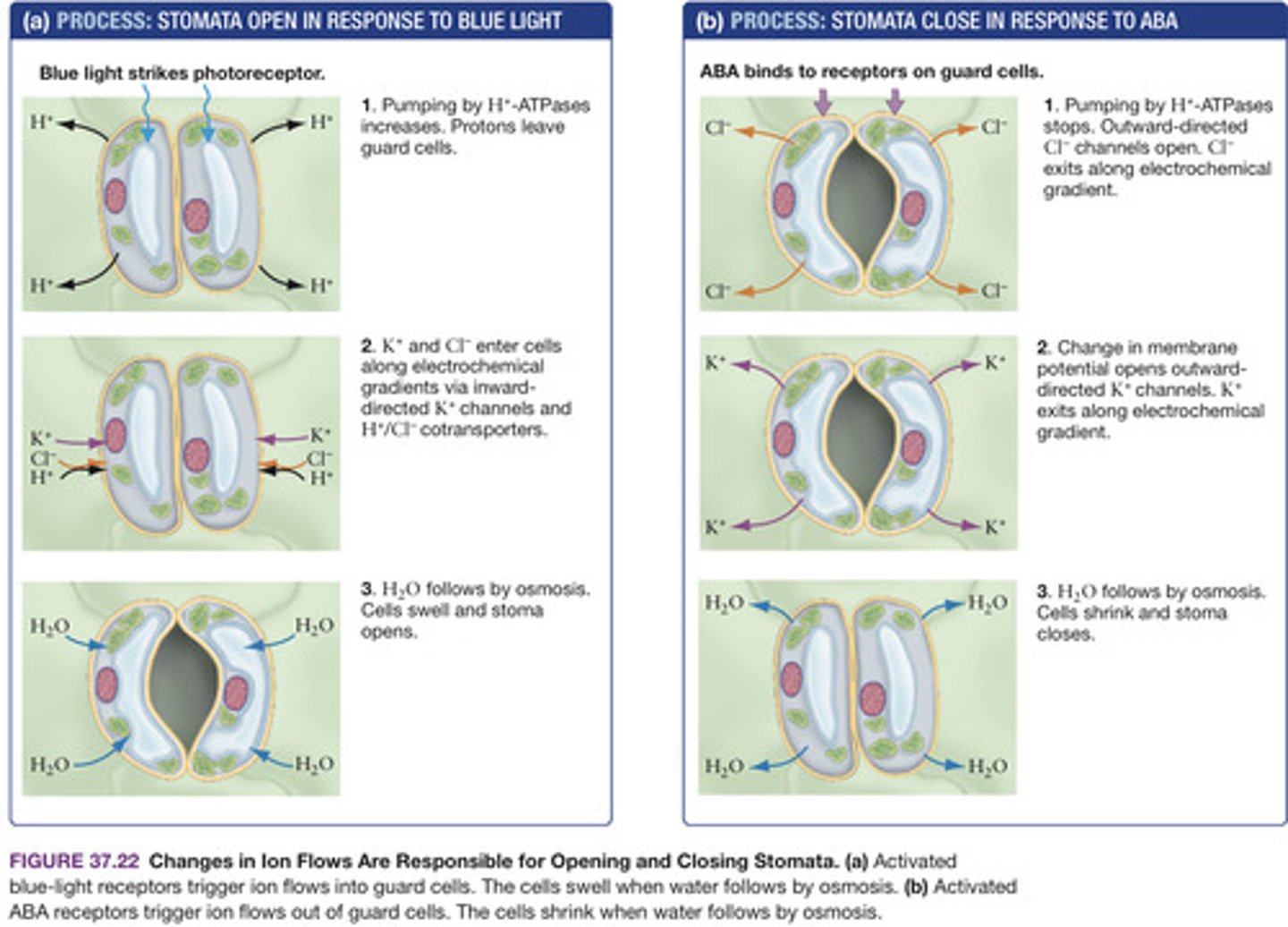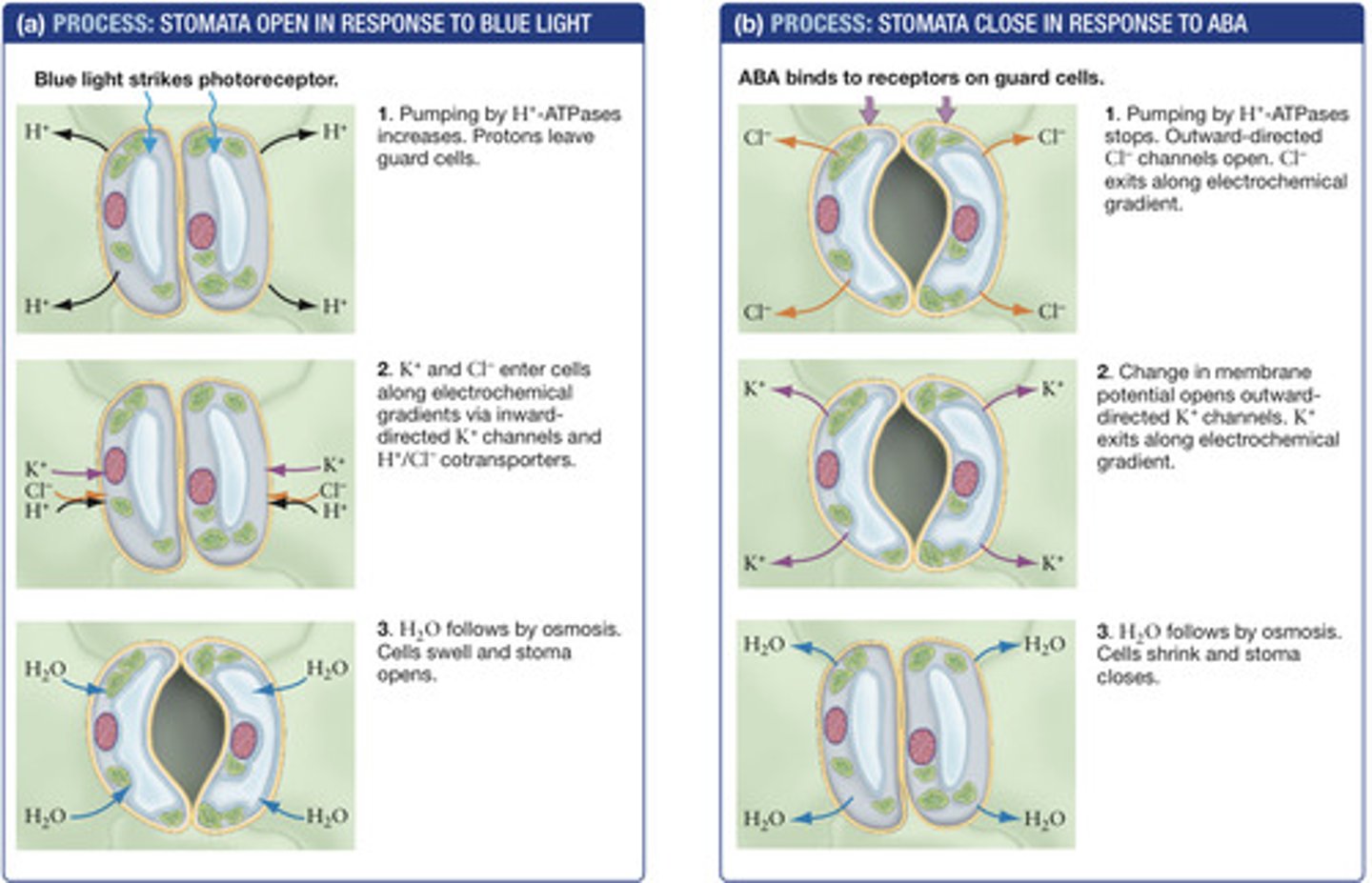BIOL220 Transport: Regulation of Stomata
1/13
There's no tags or description
Looks like no tags are added yet.
Name | Mastery | Learn | Test | Matching | Spaced |
|---|
No study sessions yet.
14 Terms
Abscisic Acid (ABA) (definition, other)
Definition: A plant hormone that inhibits growth; it stimulates stomatal closure and triggers dormancy.
Other:
- ABA is produced in root cells under conditions of dry soil. ABA from roots is transported to leaves and it serves as an early warning of drought stress.
- ABA overrides the signal from the blue-light photoreceptors.
- ABA causes stomata to close to conserve water.
- Whether it acts on guard cells or seeds, ABA fulfills a general role in plants as a dormancy or "no-growth" signal. In many cases, its action depends on input from other hormones and photoreceptors. To survive and reproduce successfully, plants have to integrate information from a variety of sources.
Gibberlins (definition, other)
Definition: A class of hormones, found in plants and fungi, that stimulate growth. Gibberellic acid (GA) is one of the major gibberellins.
Other:
Photoreceptor (definition, other)
Definition: A molecule, a cell, or an organ that is specialized to detect light.
Other:
Phototropins (definition, other)
Definition: A class of plant photoreceptors that detect blue light and initiate various responses.
Other: Are pigments
Stoma (definition, other)
Definition: (plural: stomata) Generally, a pore or opening. In plants, a microscopic pore on the surface of a leaf or stem through which gas exchange occurs; typically surrounded by specialized cells that open the pore.
Other:
- Closing stomata is an adaptive response when roots cannot find adequate water, because continued transpiration would lead to wilting and potential tissue damage.
- Activation of PHOT by blue light leads to water entry in the vacuoles of guard cell making them turgid, and stomatal opening; activation of ABA receptors leads to water exiting the vacuoles of guard cells making them flaccid, and stomatal closing.

Guard Cell (definition, other)
Definition: One of two specialized, crescent-shaped cells forming the border of a plant stoma. Guard cells can change shape to open or close the stoma.
Other:
- When the vacuoles of guard cells are filled with water, the cells are turgid. The shape of turgid guard cells forms an open pore between the two cells, which allows gas exchange between the atmosphere and the leaf interior.
- When vacuoles lose water and guard cells become flaccid and lack turgor, cell shape changes in a way that closes the pore and stops both gas exchange and water loss via transpiration.
- Activation of PHOT by blue light leads to water entry in the vacuoles of guard cell making them turgid, and stomatal opening; activation of ABA receptors leads to water exiting the vacuoles of guard cells making them flaccid, and stomatal closing.
- Guard-cell opening and closing is based on changes in the activity of H+-ATPases and ion transporters in the plasma membrane.
- When photoreceptors are stimulated by blue light, large numbers of protons are pumped out of each guard cell. As a result, the interior of guard cells develops a negative charge.
- increased H+-ATPase activity creates a strong electrochemical gradient that brings potassium and chloride ions into the interior of the guard cells. Water follows the incoming ions via osmosis. The cells swell and pores open.

What happens when ABA reaches guard cells?
(1) H+-ATPases are inhibited.
(2) Channels that allow chloride and other anions to leave along their electrochemical gradients are opened.
(3) When the anions leave guard cells, the change in membrane potential causes outward-directed potassium channels to open. Large amounts of K+ leave the cells, and water follows by osmo-
sis. The result is a loss of turgor and closing of the pore.
Brassinosteroids (definition, other)
Definition: A family of steroid hormones found in plants; they stimulate growth.
Other:
- In plants, growth spurts are triggered by surges in similar steroid hormones called brassinosteroids.
- Brassinosteroids are steroid hormones
- Brassinosteroids promote growth and are a key regulator of overall body size in plants.
- Brassinosteroids, are more hydrophilic than animal hormones and never enter the cell. Instead, they bind to receptors on the plasma membrane and activate signal transduction events—phosphorylation cascades—that lead to changes in gene expression.
- The genes for the synthesis of brassinosteroids appear to be homologous with the genes required for steroid hormone synthesis in animals, meaning that they are derived from a similar gene in the common ancestor of plants and animals.
Steroid (definition)
Definition: A class of lipid with a characteristic four-ring hydrocarbon structure.
Other:
Senescence (definition, other)
Definition: The genetically programmed, active process of aging.
Other:
- Senescence is a regulated process of aging and eventual death of an entire organism or organs such as fruits and leaves.
- Senescence is regulated by complex interactions between several hormones in response to changes in temperature, light, and other factors.
Ethylene (definition)
Definition: A gaseous plant hormone associated with senescence that induces fruits to ripen and flowers to fade.
Other:
- The hormone most strongly associated with senescence is ethylene.
- Ethylene is simple in structure and active at small concentrations.
- Ethylene is a gas at normal temperatures.
- Ethylene is synthesized from the amino acid methionine
- Is involved in the following senescence events:
- Ethylene influences plant growth, and it is a stress hormone induced by drought and other conditions.
- Ethylene regulates a surprisingly large range of physiological responses.
- Ethylene is involved in the following senescence events:
1. Fruit ripening, which hastens the aging and rotting of fruit.
2. Flowers fading.
3. Leaf abscission—their detachment and fall.
- Ethylene induces:
(1) The production of some of the enzymes required for the ripening process.
(2) An increase in cellular respiration, which furnishes ATP.
Stomata Opening Steps
(1) Blue Light signal is received by a photoreceptor (Phototropin, a pigment and protein also called PHOT). Signal reception causes the protein shape to change. The protein is phosphorylated which activates it.
(2) The signal is transferred and amplified via a signal cascade in which phosphorylation occurs.
(3) H+ATPase pumps protons out of the guard cells. This creates a proton gradient and an electrical gradient. The guard cell becomes more negative as protons leave the cell.
(4) K+ enters guard cell via K+ inward channel moving with it's electrical gradient (moving from a positive charge environment to a negative charge environment).
(5) Cl-/H+ symporter transports Cl- and H+ simultaneously. H+ATPase makes the transport of H+ into the guard cell favorable, so that Cl- can move against it's electrical gradient.
(6) The solute concentration increases, which means that the solute potential decreases. This results in lowering the water potential in the guard cell.
(7) H20 moves into the guard cell, moving from the apoplast with a high water potential to the symplast with a low water potential.
(8) The pressure potential increases as water moves into the cell, and the guard cell becomes turgid, opening the stomata.

Stomata Closing Steps
A. Stress Condition:
(1) When soil is dry, ABA is produced in the root cells and then transported to the leaves.
(2) ABA (the signal) is received by an ABA receptor. The signal is transferred and amplified via a signal cascade in which phosphorylation occurs.
(3) H+ATPase activity decreases. No protons are being actively up pumped out making the guard cell (symplast) more positive.
(4) Cl- moves out of guard cells moving with it's electrical gradient (moving from a high negative charge to positive charge).
(5) K+ moves out of the cell moving with it's electrcal and chemical al gradient (high concentration and positive charge to low concentration and negative charge). This makes the apoplast more positive, and the symplast more negative.
(6) As a result, solute concentration decreases, thus solute potential increases. Therefore water potential increases.
(7) H20 will leave the guard cell moving from an area of high water potential to an area of low water potential.
(8) As water leaves the guard cell, Pressure Potential decreases, and guard cells become flaccid. As a result the stomata closes.
B. Unstressed condition:
(1) There is no blue light signal.
(2) H+ATPase activity decreases. No protons are being actively up pumped out making the guard cell (symplast) more positive.
(3) Cl- moves out of guard cells moving with it's electrical gradient (moving from a high negative charge to positive charge).
(4) K+ moves out of the cell moving with it's electrical and chemical al gradient (high concentration and positive charge to low concentration and negative charge). This makes the apoplast more positive, and the symplast more negative.
(5) As a result, solute concentration decreases, thus solute potential increases. Therefore water potential increases.
(6) H20 will leave the guard cell moving from an area of high water potential to an area of low water potential.
(7) As water leaves the guard cell, Pressure Potential decreases, and guard cells become flaccid. As a result the stomata closes.

When are stomata closed? When are they open?
- Fully Closed: Stomata are only fully closed in the presence of ABA.
- Partially Open: They can be partially open in the presence of light other than blue light. Guard cells have chloroplasts that do photosynthesis (chlorophyll absorb violet, red, some orange, and some yellow light). Non-blue light allows photosynthesis to occur which increases the sugar concentration inside the cell. As concentration increases, solute potential decreases and water flows into the guard cell, which opens the stoma slightly.
- Completely Open: Presence of Blue light